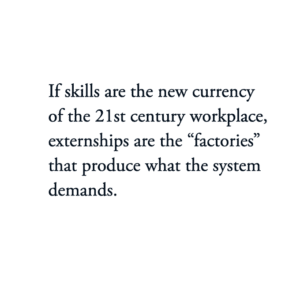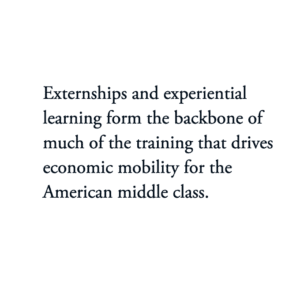For decades, externships have been a vital — and underappreciated — part of the education and workforce training infrastructure in the United States. In many ways, they bear a close resemblance to traditional internships: an opportunity to gain short-term, hands-on experience in a given industry before pursuing a career in that industry.
But a closer look reveals important differences. Internships, for all their well-deserved reputation as grunt work, also carry a degree of prestige. After all, Ivy League grads boast of summer internships at Deloitte or JPMorgan Chase. Externships, on the other hand, tend to require participants to roll up their sleeves. They have become a mainstream solution across a variety of so-called “middle skill” professions — health care, animal care, financial planning and skilled trades, to name a few.
Rather than a nice-to-have shadowing experience, externships are the anchor for experiential learning in a variety of fields that make up the majority of the U.S. labor market, but they tend to be overlooked in the national narrative on education. In many cases, they are tied to academic requirements for accredited credentialing programs, which emphasize “learning by doing” as a complement to traditional pen-and-paper or online curricula. Simply put, if skills are the new currency of the 21st century workplace, externships are the “factories” that produce what the system demands.
But amid the onslaught of COVID-19, the externship landscape is being thrown into chaos. Across scores of front-line professions, notably in allied health, today’s hands-on experience requirements are neither practical nor often even attainable. Many of the most common externship settings — veterinary hospitals, urgent care facilities and pharmacies — have shut off opportunities, making it impossible for learners to complete one of the most critical steps in their career training path.
In the early days of the pandemic, some of these restrictions — like nursing school requirements in California — threatened to keep thousands of health care providers from offering support to patients in need. That particular requirement has been lifted. But many other programmatic accreditors and federal and state regulators have not granted the same degree of flexibility.
The American Veterinary Medical Association’s Committee on Veterinary Technician Education and Activities, for instance, has made accommodations that cater only to veterinary technician learners enrolled in ground-based programs that operate on a traditional semester calendar who already had access to a lab or local vet hospital where they could demonstrate their skills. The American Society of Health-System Pharmacists, similarly, is replacing some externships for aspiring pharmacy technicians with simulations, but those simulations must be completed on-site in a lab. Neither organization has acknowledged the need for a different type of accommodation for online learners — despite the fact that more than half of all veterinary technician students, and many pharmacy technician students, take their courses online. And in all cases, some more immediate needs are not being met; for instance, no organization has made any effort to invest in personal protective equipment for the externs who they still allow to participate.

There are good reasons for organizations to maintain requirements for in-person externships. It remains the case that nothing can truly replace hands-on experience as a driver of learning. And as states begin to slacken their social distancing mandates, it may be possible to return to an in-person model relatively quickly. But at this point, the rigidity of associations and accrediting bodies has meant that thousands of students around the country have already lost opportunities to complete their education and begin their career path.
In the months to come, we will need middle-skill workers and learners more than ever. In so many ways, COVID-19 is pushing policymakers and businesses to rethink calcified practices and begin to explore a “new normal.” Can the same thing happen for the organizations that are now holding externships back? What will it take to encourage alternative externship methods — rather than a status quo that is squandering the potential and prospects of a generation of students?
Fortunately, emerging policies and practices demonstrate the way that organizations can reimagine experiential learning in the wake of the pandemic. The Financial Planning Association recently became one of the bigger externship providers to move its externships virtual, following on the heels of similar announcements from Google’s internship program and others. CMS has eliminated the requirement for physicians and other practitioners to perform in-person visits at nursing homes, and states like Minnesota have waived the requirement for an initial face-to-face visit for telemedicine in schools. Associations like ABHES and MAERB have also changed their policies to allow virtual externships and simulated labs for many of their programs during the pandemic.
These are critically important bellwether examples. But in many industries, they remain the exception, not the norm. Moving to virtual models, while retaining the quality and integrity of the in-person experience, will not be easy in every field. But if the U.S. workforce is to recover from this crisis, we will need to take risks on emerging models that have shown promise but may not yet be widely adopted. In the case of the health care professions mentioned above, that could include ideas like inviting externs to telehealth visits in order to replicate valuable interpersonal experiences like mentorship in a remote setting.

As the country plans for a new normal, HR and learning leaders will have a critical role to play in reimagining the role of externships. Given their role as the primary liaison with training providers, talent development professionals should consider how advances in technology may make new externship opportunities possible. Recognizing the potential of virtual externships, and championing more flexible remote externship policies, can help organizations expand their talent pool at a time when it has never been more important.
For many institutions often regarded as slow-moving, the crisis has accelerated the process of innovation and experimentation and short-circuited many barriers to the adoption of new practices. Changes that might have taken years, simply because of the stickiness of the status quo, are now happening in a matter of months or even weeks. But in far too many middle-skill industries, those changes have yet to take hold — often because bureaucratic realities or adherence to legacy practices get in the way. Externships and experiential learning form the backbone of much of the training that drives economic mobility for the American middle class. Without those jobs, we won’t recover. And unless we rethink the way we train for those jobs, they may remain empty at a time when we need them the most.
















